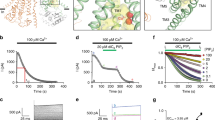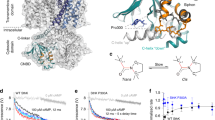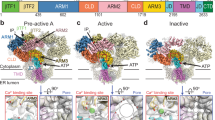Abstract
Phosphatidylinositol bisphosphate (PIP2) directly regulates functions as diverse as the organization of the cytoskeleton, vesicular transport and ion channel activity. It is not known, however, whether dynamic changes in PIP2 levels have a regulatory role of physiological importance in such functions. Here, we show in both native cardiac cells and heterologous expression systems that receptor-regulated PIP2 hydrolysis results in desensitization of a GTP-binding protein-stimulated potassium current. Two receptor-regulated pathways in the plasma membrane cross-talk at the level of these channels to modulate potassium currents. One pathway signals through the βγ subunits of G proteins, which bind directly to the channel. Gβγ subunits stabilize interactions with PIP2 and lead to persistent channel activation. The second pathway activates phospholipase C (PLC) which hydrolyses PIP2 and limits Gβγ-stimulated activity. Our results provide evidence that PIP2 itself is a receptor-regulated second messenger, downregulation of which accounts for a new form of desensitization.
This is a preview of subscription content, access via your institution
Access options
Subscribe to this journal
Receive 12 print issues and online access
$209.00 per year
only $17.42 per issue
Buy this article
- Purchase on Springer Link
- Instant access to full article PDF
Prices may be subject to local taxes which are calculated during checkout







Similar content being viewed by others
References
Kubo, Y., Reuveny, E., Slesinger, P. A., Jan, Y. N. & Jan, L. Y. Primary structure and functional expression of a rat G-protein-coupled muscarinic potassium channel. Nature 364, 802–806 (1993).
Dascal, N., Schreibmayer, W., Lim, N. F., Wang, W., Chavkin, C., DiMagno, L., Labarca, C., Kieffer, B. L., Caveriaux-Ruff, C., Trollinger, D., Lester, H. A. & Davidson, N. Atrial G protein-activated K+ channel: Expression cloning and molecular properties. Proc. Natl Acad. Sci. USA 90, 10235–10239 (1993).
Krapivinsky, G., Gordon, E. A., Wickman, K., Velimirovic, B., Krapivinsky, L. & Clapham, D. E. The G-protein-gated atrial K+ channel IKACh is a heteromultimer of two inwardly rectifying K+-channel proteins. Nature 374, 135–141 (1995).
Caulfield, M. P. & Birdsall, N. J. M. Classification of muscarinic acetylcholine receptors. International Union of Pharmacology. XVII. Pharmacol. Rev. 50, 279–290 (1998).
Logothetis, D. E., Kurachi, Y., Galper, J., Neer, E. J. & Clapham, D. E. The βγ subunits of GTP-binding proteins activate the muscarinic K channel in heart. Nature 325, 321–326 (1987).
Krapivinsky, G., Krapivinsky, L., Wickman, K. & Clapham, D. E. Gβγ binds directly to the G protein-gated K+ channel, IKACh. J. Biol. Chem. 270, 29059–29062 (1995).
Yamada, M., Inanobe, A. & Kurachi, Y. G protein regulation of potassium ion channels. Pharmacol. Rev. 50, 723–757 (1998).
Kurachi, Y., Nakajima, T. & Sugimoto, T. Short-term desensitization of muscarinic K+ channel current in isolated atrial myocytes and possible role of GTP-binding proteins. Pflügers Arch. 410, 227–233 (1987).
Wu, D., Jiang, H., Katz, A. & Simon, M. I. Identification of critical regions on phospholipase C-beta 1 required for activation by G-proteins. J. Biol. Chem. 268, 3704–3709 (1993).
Stauffer, T. P., Ahn, S. & Meyer, T. Receptor-induced transient reduction in plasma membrane PtdIns(4,5)P2 concentration monitored in living cells. Curr. Biol. 8, 343–346 (1998).
Varnai, P. & Balla, T. Visualization of phosphoinositides that bind pleckstrin homology domains: Calcium- and agonist-induced dynamic changes and relationship to myo-[3H]inositol-labeled phosphoinositide pools. J. Cell Biol. 143, 501–510 (1998).
Hirose, K., Kadowaki, S., Tanabe, M., Takeshima, H. & Masamitsu I. Spatiotemporal dynamics of inositol 1,4,5-triphosphate that underlies complex Ca2+ mobilization patterns. Science 284, 1527–1530 (1999).
Yim, D. L., Opresko, L. L., Wiley, H. S. & Nuccitelli, R. Highly polarized EGF receptor tyrosine kinase activity initiates egg activation in Xenopus. Dev. Biol. 162, 41–55 (1994).
Hilgemann, D. W. Cytoplasmic ATP-dependent regulation of ion transporters and channels: mechanisms and messengers. Annu. Rev. Physiol. 59, 193–220 (1997).
Sui, J. L., Petit-Jacques, J. & Logothetis, D. E. Effect of phosphatidylinositol phosphates on the gating of G-protein-activated K+ channels. Curr. Topics Membranes 46, 337–354 (1999).
Hilgemann, D. W. & Ball, R. Regulation of cardiac Na+, Ca2+ exchange and KATP potassium channels by PIP2. Science 273, 956–959 (1996).
Fan, Z. & Makielski, J. C. Anionic phospholipids activate ATP-sensitive potassium channels. J. Biol. Chem. 272, 5388–5395 (1997).
Baukrowitz, T., Schulte, U., Oliver, D., Herlitze, S., Krauter, T., Tucker, S. J., Ruppersberg, J. P. & Fakler, B. PIP2 and PIP as determinants for ATP inhibition of KATP channels. Science 282, 1141–1144 (1998).
Shyng, S.-L. & Nichols, C. G. Membrane phospholipid control of nucleotide sensitivity of KATP channels. Science 282, 1138–1141 (1998).
Huang, C.-L., Feng, S. & Hilgemann, D. W. Direct activation of inward rectifier potassium channels by PIP2 and its stabilization by Gβγ. Nature 391, 803–806 (1998).
Sui, J.-L., Petit-Jacques & Logothetis, D. E. Activation of the atrial KACh channel by the βγ subunits of G proteins or intracellular Na+ ions depends on the presence of phosphatidylinositol phosphates. Proc. Natl Acad. Sci. USA 95, 1307–1312 (1998).
Zhang, H., He, C., Yan, X., Mirshahi, T. & Logothetis, D. E. Specific PIP2 interactions with inwardly rectifying K+ channels determine distinct activation mechanisms. Nature Cell Biology 1, 183–188 (1999).
Liou, H. H., Zhou, S. S. & Huang, C. L. Regulation of ROMK 1 channel by protein kinase A via a phosphatidylinositol 4,5-bisphosphate-dependent mechanism. Proc. Natl Acad. Sci. USA 96, 5820–5825 (1999).
Sui, J. L., Chan, K. W. & Logothetis, D. E. Na+ activation of the muscarinic K+ channel by a G-protein-independent mechanism. J. Gen. Physiol. 108, 381–391 (1996).
Petit-Jacques, J., Sui, J.-L. & Logothetis, D. E. Synergistic activation of GIRK channels by Na+, Mg2+ and Gβγ subunits. J. Gen. Physiol. 114, 673–684 (1999).
Ho, I. H. M. & Murrell-Lagnado, R. D. Molecular mechanism for sodium dependent activation of G protein-gated K+ channels. J. Physiol. 520, 645–651 (1999).
Logothetis, D. E. & Zhang, H. Gating of G protein-sensitive inwardly rectifying K+ channels through phosphatidylinositol 4,5-bisphosphate. J. Physiol. 520, 630 (1999).
Xie L.-H., Horie, M. & Takano M. Phospholipase C-linked receptors regulate the ATP-sensitive potassium channel by means of phosphatidylinositol 4,5-bisphosphate metabolism. Proc. Natl Acad. Sci. USA 96, 15292–15297 (1999).
Chuang, H.-H., Yu, M., Jan, Y. N. & Jan, L. Y. Evidence that the nucleotide exchange and hydrolysis cycle of G proteins causes acute desensitization of G-protein gated inward rectifier K+ channels. Proc. Natl Acad. Sci. USA 95, 11727–11732 (1998).
Kim, D. & Pleumsamran, A. Cytoplasmic unsaturated free fatty acids inhibit ATP-dependent gating of the G protein-gated K+ channel. J. Gen. Physiol. 115, 287–304 (2000).
Liman, E. R., Tytgat, J. & Hess, P. Subunit stoichiometry of a mammalian K+ channel determined by construction of multimeric cDNAs. Neuron 9, 861–871 (1992).
Muir, T. M., Hair, J., Inglis, G. C., Dow, J. W., Lindop, G. B. M. & Leckie, B. J. Dexamethasone-induced differentiation of atrial myocytes in culture. Am. J. Physiol. 263, H 722–H 729 (1992).
Vivaudou, M., Chan, K. W., Sui, J. L. Jan L.Y., Reuveny, E. & Logothetis, D. E. Probing the G-protein regulation of GIRK 1 and GIRK 4, the two subunits of the KACh channel, using functional homomeric mutants. J. Biol. Chem. 272, 31553–31560 (1997).
Petersen, C. C. & Berridge, M. J. The regulation of capacitative calcium entry by calcium and protein kinase C in Xenopus oocytes. J. Biol. Chem. 269, 32246–32253 (1994).
Acknowledgements
We are grateful to X. Yan for preparation of oocytes, S. Henderson for help with the confocal experiments, and I. Wolf for peptide synthesis. We thank H. S. Wiley (University of Utah), X-Y. Huang (Cornell University Medical College) and T. Meyer (Duke University) for their kind gifts of EGF receptor, M1 receptor and GFP–PH cDNAs, respectively. We also thank R. Anderson, D. Clapham, M. Greenberg, R. Iyengar, R. Margolskee, S. Sealfon, M. Ming Zhou and members of the Logothetis lab for critical comments on the manuscript. This work was supported by grants to D.E.L. from the NIH (HL54185 and HL59949). T.M. was supported by NIH Training Grant DK 07757 and a Charles H. Revson fellowship.
Correspondence and requests for materials should be addressed to D.E.L.
Author information
Authors and Affiliations
Corresponding author
Rights and permissions
About this article
Cite this article
Kobrinsky, E., Mirshahi, T., Zhang, H. et al. Receptor-mediated hydrolysis of plasma membrane messenger PIP2 leads to K+-current desensitization . Nat Cell Biol 2, 507–514 (2000). https://doi.org/10.1038/35019544
Received:
Revised:
Accepted:
Published:
Issue Date:
DOI: https://doi.org/10.1038/35019544
This article is cited by
-
Different molecular pathways are disrupted in Pyoderma gangrenosum patients and are associated with the severity of the disease
Scientific Reports (2023)
-
Pre- and post-synaptic roles for DCC in memory consolidation in the adult mouse hippocampus
Molecular Brain (2020)
-
Dual activation of neuronal G protein-gated inwardly rectifying potassium (GIRK) channels by cholesterol and alcohol
Scientific Reports (2017)
-
Control of neuronal excitability by Group I metabotropic glutamate receptors
Biophysical Reviews (2017)
-
Cross-signaling in metabotropic glutamate 2 and serotonin 2A receptor heteromers in mammalian cells
Pflügers Archiv - European Journal of Physiology (2016)



